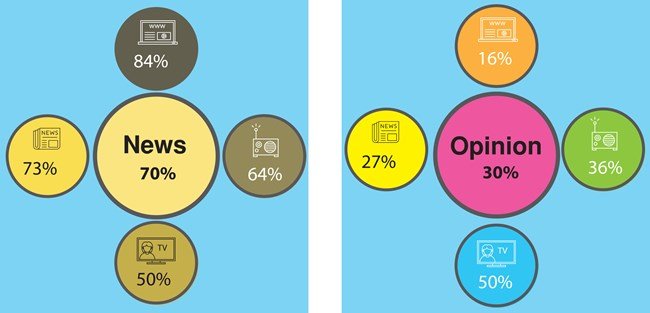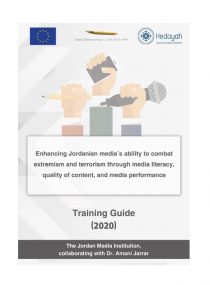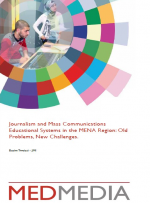Image:

05 Nov 2016
<ul>
<li><strong>Clear Gender Discrimination Against Women and Improvement in Coverage of Governorates</strong></li>
<li><strong>News Content Highest and Clear Presence of Neutral Coverage</strong></li>
<li><strong>Weak Balance and Great Dependence on One Source</strong></li>
<li><strong>Confusing Advertisements With News Worst Phenomenon in Election Coverage</strong></li>
</ul>
<br />
<strong>Amman - Jordan Media Institute</strong><br />
<br />
The Jordan Media Institute (JMI) has issued its fourth report on monitoring Jordanian media coverage of elections to the 18th Lower House of Parliament. It included monitoring a sample of 20 media outlets. The sample contained four daily newspapers, Al Dustour, Al Ra'i, Al Ghad, and Al Sabeel; four local radio stations, Jordan Radio (Main Program), Al Balad Radio, Hayat FM, and Sawt Al Janub; and four TV stations, Jordan TV, Roya TV, Al Yarmouk TV, and Al Haqiqa Al Dawliya. The monitoring was carried out within the framework of a project funded by the US Agency for International Development (USAID), which is part of a project for supporting civil society initiatives implemented by FHI 360.<br />
<br />
The monitoring started on 15 August, which preceded the day of registering candidates and the launch of election campaigns, and ended on the evening of 27 September. During the monitoring period, the JMI issued three successive monitoring reports.<br />
<br />
According to the final report, the total number of election-related items published in the media throughout the period of the monitoring was 11,413, of which news items accounted for 70.0%, totaling 7,987 items, while opinion pieces accounted for 30.0%, totaling 3,426 items.<br />
<br />
The results of the monitoring showed the quantitative and qualitative development in the coverage of media outlets of the parliamentary elections. The coverage of the 2016 elections constituted a new and good addition, which will help accumulate the experiences of Jordanian journalists and media persons in electoral coverage in spite of the continuation of some existing problems, such as not separating ownership of media outlets from editorial policy in some establishments and the problem of deliberate confusion of news with advertisements, which constituted the worst phenomenon in the coverage of these elections. Besides, most of the media outlets that were monitored violated laws and legislation with regard to election campaigning, specifically on the election silence day, including the Press and Publications Law, Election Law of 2016, and the Instructions of the Independent Election Commission (IEC) on Election Campaigns. These media outlets also violated codes of conduct, chief of which is the code of conduct issued by the JMI on the day of the launch of election campaigns, the code of honor of the Press Association, and other international standards, especially on the election silence day, which was wholly violated without holding any violating media outlet legally accountable.<br />
<br />
<strong>First, Printed Press:</strong><br />
<br />
The daily press led other media outlets in terms of the total number of election items by 56.0%, including 73.0% news items and 27.0% opinion pieces. The space of coverage totaled 190,268 square centimeters. The report showed that Al Dustour and Al Ghad had the highest coverage of the elections quantitatively. The coverage of Al Dustour was 30.8%, while Al Ghad was 30.5% of the total items in the printed press.<br />
<br />
The report noted that activities of candidates were the top interest of the printed press by 12.7%, followed by interest in election-related logistical and administrative actions by 12.1%, then general election participation in third place by 9.7%. Interest in the affairs of women quota was 6.0%.<br />
<br />
The report stated that experts and specialists continued to be the most active politically in the coverage of the printed press by 24.4%, followed by the IEC by 16.4%, then civil society organizations by 14.9%, and then lists and blocs by 10.6%. The government came fifth by 6.7%, while persons with disability were the least interesting as political actors in the media content by 0.5%.<br />
<br />
The report confirmed that neutral coverage was the highest in terms of the trends of neutrality in the printed press by 57.2%, followed by positive coverage by 21.5%. Negative coverage came third with a very minor difference by 21.0%. The printed press also depended in half of its coverage, in terms of the values of balance, on one source or one opinion by 50.8%, while its dependence on two sources or more or presenting two opinions of more in its election coverage totaled 35.3%.<br />
<br />
On the geographic identity of the coverage of the printed press, the report said that general national issues were among its top interests by 62.4%. The Irbid governorate received the highest interest in the election coverage ahead of the capital, Amman, by 6.3%. The capital came second by 5.3%, while coverage of the other governorates improved a little in the second half of election campaigns.<br />
<br />
The report confirmed that women continued to be the least present in the printed press in terms of gender in favor of men, who had greater presence by almost 10 times, thus keeping women at the bottom of the scale of interest of the printed press. It noted that the presence of men in the coverage of the printed press was 74.2%, while the presence of women was 7.2%. The mixed presence of women and men was 11.0%.<br />
<br />
<strong>Second, Radio Stations: </strong><br />
<br />
The report said that radio broadcasts of election coverage totaled 94 hours, 21 minutes, and 56 seconds, during which 1,783 items were carried. News items totaled 66.4%, while opinion pieces totaled 35.6%. Jordan Radio was the highest broadcaster of election coverage by 34% of the total items of radios. Al Balad Radio came second by 30%, and then Sawt Al Janub Radio.<br />
<br />
The report said that election-related logistical and administrative actions topped the interests of radios by 14.5%, followed by interest in the activities of candidates by 8.9%, awareness-raising and education about the elections in third place by 8.6%, followed by interest in the balloting in fourth place by 8.5%, and then election violations in fifth place by 7.5%.<br />
<br />
According to the final results of the report, the IEC continued to be the first political actor in the coverage of radio stations of parliamentary elections by 32.0%, followed by experts and specialists in second place by 17.1%, civil society organizations in third place by 16.5%, the government in fourth place by 8.5%, and voters in fifth place by 7.4%.<br />
<br />
On coverage trends of radios, the report said that neutral coverage was the highest by 52.0%, while positive coverage came second by 31.0%, and negative coverage in third place by 16.9%. In terms of the standards of balance, the report revealed that the dependence by radio stations on one source or presenting one opinion in their election coverage was the highest by 53.7%, followed by dependence on two sources or opinions or more by 25.9%.<br />
<br />
According to the report, interest in general national issues came first by 68.0%. The report revealed that interest in gender and in women as actors and producers of radio media content remained at the bottom of the scale of radio coverage. Women ranked very low by 5.8%, with a difference of almost 11 times greater in favor of men whose presence in the radio media content was 71.1%. This consolidates the question of gender discrimination against women. The mixed presence of men and women in radio coverage totaled 13.2%.<br />
<br />
<strong>Third, TV Stations:</strong><br />
<br />
The final results of the monitoring showed that TV broadcasts totaled 109 hours, 30 minutes, and 25 seconds, during which 1,585 items were carried. The dependence of TV channels on news items and opinion pieces was close. News items totaled 50.2%, while opinion pieces totaled 49.8%. Jordan TV led other stations in terms of the broadcasting hours by 32%. Roya TV was close by 31%.<br />
<br />
The report noted that TV stations were primarily interested in the results of the elections by 9.7%, followed by interest in election participation by 9.2%. The polling day came third by 9.1%, while interest in logistical actions came fourth by 9.0%.<br />
<br />
The report showed that the IEC topped the list of the five political actors in TV coverage by 31.0%, followed by voters by 14.3%, then lists and blocs in third place by 13.0%. Experts and specialists came fourth by 11.5% and then civil society in fifth place by 7.7%.<br />
<br />
On neutrality trends in TV coverage, the report confirmed that positive coverage was the highest by 45.5%, then neutral coverage second by 35.6%, and negative coverage third by 15.8%. In terms of balance trends, TV channels depended in their election coverage on one source or the presentation of one opinion by 51.1%, while subjects broadcast by TV channels that depended on one source or more or presenting two opinions or more were 28.6%.<br />
<br />
Regarding the geographic identity of TV coverage, the report noted that the coverage of general national issues was the main interest of TV channels by 66.2%. The capital, Amman, came second by 7.1%, then the districts of the Bedouin of the center, north, and south third by 4.9%. The coverage of other governorates also witnessed improvement in the second half of the election campaign.<br />
<br />
The report confirmed that men remained in first place in terms of presence and effectiveness in media content compared with women whose presence was 6.1% versus 72.6% for men. The joint presence of men and women in TV coverage was 17.4%.<br />
<br />
<strong>Fourth, Electronic Press:</strong><br />
<br />
The report said that the electronic press published 1,610 election subjects and items throughout the period that was monitored with a total of 376,356 words. The electronic press depended on the news format by 84.3%, while opinion pieces in their coverage were 15.7%. Saraya news site came first in terms of the quantity of coverage by 30.1%, followed by Al Bosala news site by 18.8% and then Khaberni.<br />
<br />
The report indicated that interest in procedures of registration for candidates and electoral lists was the top priority for the electronic press by 13.3%, followed by interest in the results of the elections in second place by 11.1%, then in third place interest in election-related logistical and administrative actions by 9.1%, and then interest in the voting by 8.4%.<br />
<br />
The JMI report confirmed that the IEC emerged as the first political actor in the overall coverage of the electronic press by 27.3%, then electoral lists and blocs second by 17.8%, then specialists by 10.7%, while the activities of bodies observing the elections received 6.5%.<br />
<br />
On coverage trends, the report revealed that neutral coverage in the electronic press was 34.8%, negative coverage was 34.3%, while positive coverage came third by 29.4%. The dependence of the electronic press on one source or one opinion was the highest in terms of the distribution of items and space according to balance by 42.8%. The items that did not depend on any source came second by 22.1%.<br />
<br />
On the geographic identity of the coverage, the report indicated that general national issues were the main interest of the electronic press by 49.3%. The capital, Amman, came first, in terms of the geographic identity in election coverage, which is the highest among the media that were monitored by 17.6%, followed by mixed election coverage by 11.1%. The governorate of Irbid came third by 4.4%, then the Bedouin districts fourth by 3.4%, and then Al Zarqa governorate fifth by 3.2%. The camps registered the lowest interest by 0.2%.<br />
<br />
The JMI report confirmed that men continued to be ahead of women as producers of electronic media content and present in it by 63.4% versus the presence of women, which totaled 5.5%, which is the lowest percentage to be registered in all the media that were monitored, thus revealing the extent of gender discrimination against women in the electronic press. The coverage in which men and women appeared as actors and producers of media content was 20.7%. <br />



